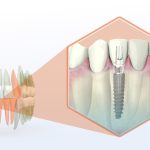If you yearn for a more aligned smile but recoil at the thought of traditional metal braces, rest assured that alternatives exist – Ceramic braces.
What are ceramic braces?
Ceramic braces fly under the radar when compared to their metallic counterparts. Instead of silver-colored metal, ceramic braces come in tooth-colored, white, or clear options, and even the connecting archwire adopts less conspicuous hues like white and frosted.
The application process mirrors that of metal braces: brackets are affixed to the front of your teeth, while rubber bands (offering a spectrum of colors) secure the archwire in its rightful place.
Despite their translucent facade, ceramic braces function identically to metal ones, correcting alignment, bite, and tooth placement. The rubber bands ensure a proper tooth migration process.
Ceramic Braces vs. Traditional Braces:
- Construction: The pivotal difference lies in the materials used. Ceramic braces can be crafted from either polycrystalline aluminum oxide or monocrystalline sapphire.
- Appearance: Both ceramic and metal braces work towards straightening your teeth and addressing issues like overbites and underbites. However, ceramic braces blend seamlessly with your tooth color, making them less conspicuous.
- Durability: Metal braces triumph in terms of durability and flexibility. Nevertheless, metal brackets can’t be bonded directly to teeth, rendering them more susceptible to detachment from tooth enamel compared to ceramic counterparts. A 2020 study in BioMed Research International reported a 7.2% failure rate for metal brackets versus 1% for ceramic brackets. However, ceramic brackets are more prone to cracking, chipping, and breaking due to their delicate construction.
- Treatment Time: Ceramic braces tend to move teeth at a slightly slower pace than traditional braces. The treatment duration with ceramic braces ranges from 18 to 36 months, while metal braces typically require 18 to 24 months (and as little as six to 12 months for less complex cases). The fragility of ceramic brackets necessitates more frequent minor adjustments over an extended period to prevent breakage.
The Efficacy of Ceramic Braces
Rest assured that ceramic braces are as effective as their metal counterparts.
Potential Side Effects of Ceramic Braces
The adhesive used to bond ceramic and metal braces to teeth may pose risks to tooth enamel. A 2019 study in Clinical, Cosmetic and Investigational Dentistry discovered that ceramic braces caused a reduction in enamel mineral content. Given their larger size, ceramic brackets may also induce discomfort, leading to irritation of the lips and cheeks. Additionally, they may provoke gum sensitivity and prove more challenging to remove than metal braces.
Are ceramic braces better than metal
Pros:
- Subtler appearance compared to traditional braces.
- Compatible with imaging tests, unlike metal braces.
- Suitable for individuals with nickel allergies.
Cons:
- Less robust than metal braces.
- Higher cost in comparison to metal braces.
- Potential for gum sensitivity.
- Removal process can be trickier.
- Risk of tooth enamel damage.
- Susceptible to staining from cigarette smoke or consumption of coffee, tea, or red wine.
How much do ceramic braces cost
The overall cost of ceramic braces typically ranges from $4,000 to $8,000, with average monthly payments of $250 over a 24-month treatment period before factoring in insurance co-payments or financing fees. This amounts to approximately $6,000.
Ceramic Braces and Insurance Coverage
Insurance coverage for ceramic braces varies widely, with each policy featuring unique stipulations such as exclusions, deductibles, copayments, or maximums. On average, insurance tends to cover approximately one-third of the total cost.
Furthermore, insurance reimbursement for ceramic braces often hinges on the nature of the dental issue being addressed. If you opt for ceramic braces primarily for their aesthetics rather than medical necessity, the additional expense may not be covered.
Are Ceramic Braces Right for You
Seasoned adolescents and mature individuals who uphold a vigilant stance towards their dietary selections, oral hygiene regimens, and holistic well-being may discover that ceramic braces represent a viable alternative. However, it becomes imperative to wholeheartedly devote oneself to a meticulous regimen of brushing and flossing, as ceramic braces present a more intricate challenge in terms of cleanliness. They proffer an exceptional choice for those yearning for a less conspicuous resolution, particularly if they do not meet the criteria for transparent aligners.



